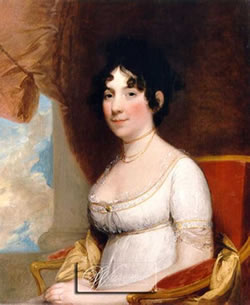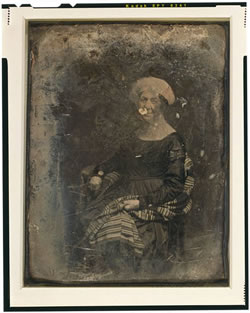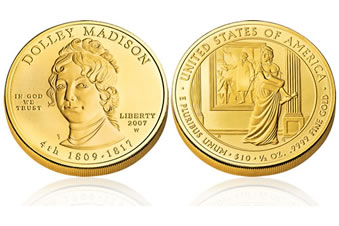Dolley Madison First Spouse Gold Coins
Dolley Madison First Spouse Gold Coins were issued by the United States Mint on November 19, 2007, and were fourth in the series of coins to honor American First Ladies.
The $10 denominated coins were struck in one-half ounce 24-karat gold and minted in proof and uncirculated versions for the $529.95 and $509.95, respectively.
When they were issued, the price of gold had increased significantly. Consequently, each Dolley Madison coin was priced $100 higher compared to the previous three in the series.
The higher prices and the volatility of gold combined with US Mint’s practice at the time to suspend bullion collector coins to readjust their prices did not serve the newest coins well. While each of the previous First Spouse Coins had sold out with limited mintages of 40,000, the Dolley Madison coins did not, and have resulting lower production numbers.
Final Mint First Spouse sales figures indicate 12,541 uncirculated and 18,355 proof coins were sold. Their resell prices are currently listed higher in the secondary market. (See examples of Dolley Madison First Spouse Gold Coins on eBay.)
Designed and sculpted by Don Everhart, Dolley’s portrait is on the obverse of the First Spouse Gold Coin in her honor. The reverse shows Dolley in the act of saving the cabinet papers and the portrait of George Washington. It was designed by Joel Iskowitz and sculpted by Don Everhart.
(See large Dolley Madison First Spouse Coin images.)
Dolley Madison Biography (1768-1849)
 No stranger to the cultural affairs of state, Dolley Madison would prove to be more than adequate to meet and exceed the expectations placed upon a First Lady of the United States. In fact, she would set a standard that subsequent first ladies would usually try and fail to attain.
No stranger to the cultural affairs of state, Dolley Madison would prove to be more than adequate to meet and exceed the expectations placed upon a First Lady of the United States. In fact, she would set a standard that subsequent first ladies would usually try and fail to attain.
Quakers John and Mary Coles Payne had their daughter, Dolley, in North Carolina in 1768. Shortly thereafter, they moved back to their home colony of Virginia, to remain there for 14 years before moving again to Philadelphia. It was here that Dolley would meet her first husband John Todd, Jr. They were married in 1790, and had two children. John passed away along with their infant son in 1793, after suffering from the yellow fever epidemic that Philadelphia was experiencing.
Mutual friend Aaron Burr introduced Dolley to Virginia Representative James Madison. Though James Madison was 17 years her senior, they married in September of 1794. This marriage forced Dolley’s expulsion from the Quakers as James was not a member. Able to shed the more conservative attire of a Quaker, Dolley found herself capable of choosing from among the finest fashions of the age. Contemporary author of the time Margaret Bayard Smith wrote:
“She looked a Queen…It would be absolutely impossible for any one to behave with more perfect propriety than she did.”
As her husband served as Secretary of State for President Thomas Jefferson (a widower of 18 years), Dolley was requested many times to serve as hostess for the country. This provided Dolley the opportunity to hone her skills in the political forum, a fact that would prove much to her advantage for years to come.
 James Madison was elected President of the United States for two terms beginning in 1809. While First Lady of the country, she proved to be a valued advisor to James. She was also known to be extremely capable of befriending needed allies of their cause, and soothing the ruffled feathers of those who were in disagreement with the policies her husband.
James Madison was elected President of the United States for two terms beginning in 1809. While First Lady of the country, she proved to be a valued advisor to James. She was also known to be extremely capable of befriending needed allies of their cause, and soothing the ruffled feathers of those who were in disagreement with the policies her husband.
Parties hosted by the First Lady were attended by all classes of society, and she could be seen mingling amongst everyone. Dolley was also the first in her position to officially take up a public cause, namely raising funds for the Lewis and Clark exploration of the Louisiana Territory.
During the War of 1812, one night found Dolley without her husband in the White House. He was off consulting with one of his generals. British troops were coming closer, and she was warned to leave the city before they arrived. Dolley refused to leave until she was sure the cabinet papers and the famous Gilbert Stuart portrait of George Washington were en route out of the city. In a letter to her sister, she accounts for these activities:
"I have pressed as many Cabinet papers into trunks as to fill one carriage; our private property must be sacrificed, as it is impossible to procure wagons for its transportation…..
Our kind friend, Mr. Carroll, has come to hasten my departure, and in a very bad humor with me, because I insist on waiting until the large picture of General Washington is secured, and it requires to be unscrewed from the wall.
This process was found too tedious for these perilous moments; I have ordered the frame to be broken, and the canvas taken out. It is done! and the precious portrait placed in the hands of two gentlemen of New York, for safe keeping.
And now, dear sister, I must leave this house, or the retreating army will make me a prisoner in it by filling up the road I am directed to take."
Additional Resources
- Dolley Madison First Spouse Coin images
- Dolley Madison First Spouse Medal images
- Dolley Madison First Spouse Coin Designs
- US Mint press announcement
- US Mint First Spouse Program
- White House Biography of Dolley Madison
- First Spouse Gold Coin Price Guide
- Madison First Spouse Coins on Sale

